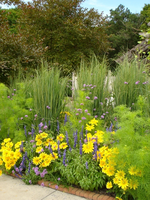Dakota Gardener: Little Bluestem, A Native Grass with Ornamental Appeal
(Click an image below to view a high-resolution image that can be downloaded)
By Esther E. McGinnis, Horticulturist
NDSU Extension
As a busy working parent, I don’t have time for prima donnas in my ornamental garden. You won’t find any fussy hybrid tea roses, delphiniums or other high-maintenance plants. My family and my students come first, which means that survival of the fittest is the theme of my garden. At the same time, I still have pride and want my landscape to be colorful and interesting.
How does one find low-maintenance plants that are as beautiful as high-maintenance plants?
The Perennial Plant Association is my secret resource. The association selects one plant each year to be its Perennial Plant of the Year. While the plant must be outstanding as far as its aesthetic features, it must also be low maintenance.
Selection criteria include adaptability over a wide range of weather and environmental conditions, relatively free from insect and disease damage, and ornamental appeal for multiple seasons. In other words, the Perennial Plant Association doesn’t have patience for prima donnas!
The 2022 Perennial Plant of the Year is little bluestem. This beautiful grass is a native of prairies on the Great Plains and serves as a host for butterfly larvae such as the Dakota skipper.
The nursery industry has several little bluestem cultivars that would look great in a home landscape. One of the most common and hardy cultivars in the plant trade is Blue Heaven. This cultivar was selected from a Minnesota prairie population for its stunning coloration, upright form and compact height.
Blue Heaven emerges in the spring with blue-green foliage. In the summer, the leaves start to develop purple highlights. By fall, the leaves are burgundy to red-colored with interesting, cottony seedheads. Yes, ornamental grasses can provide autumn color!
Unlike other native grasses, Blue Heaven doesn’t flop but instead stands up straight and works well even in a formal garden. At its maximum height, this ornamental grass is 40-48” tall and 24-30” wide.
Blue Heaven little bluestem is a great substitute for the over-used Karl Foerster feather reed grass. Once established, this ornamental grass is drought-tolerant. In general, little bluestem thrives in sandy to loamy soils and full sun but may struggle in heavy clay soils. The only maintenance that is required is to trim the dead foliage back to 6 or 8” in spring.
We even have a life hack to make ornamental grass trimming easy and less messy. Just before trimming, tie a cord around the grass. Then trim at the base. The cord will keep the grass together and the entire bundle can be removed and transported to the compost pile.
Happy gardening!
NDSU Agriculture Communication – June 21, 2022
Source: Esther McGinnis, 701-231-7971, esther.mcginnis@ndsu.edu
Editor: Kelli Anderson, 701-231-6136, kelli.c.anderson@ndsu.edu




